
- Home
- Travel Packages
- Top Destination
-
Travel Attraction
By Category
Top Attraction

- Travel Agents
- Car Rentals
- Hotels
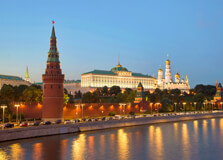
Moscow, the capital and largest city of Russia, is a dynamic metropolis steeped in history, culture, and political significance. Located on the Moskva River in the western part of the country, Moscow serves as the heart of Russia, both politically and economically. The city is a striking blend of old-world charm and modern sophistication, where historic landmarks stand alongside cutting-edge architecture. One of Moscow's most iconic features is the Kremlin, a fortified complex that houses the Russian president's residence, museums, and the famed St. Basil's Cathedral, with its colorful onion domes. The city is also home to Red Square, the historic center of Moscow, and the Bolshoi Theatre, which has been the birthplace of many world-famous performances. Moscow is a hub for art and culture, with an abundance of museums, galleries, and theaters, such as the State Tretyakov Gallery, showcasing Russian art, and the Pushkin Museum of Fine Arts. The city's metro system, known for its ornate stations, is an architectural marvel in itself. Beyond its historical and cultural significance, Moscow is a modern global city with a bustling shopping scene, diverse cuisine, and a vibrant nightlife. With its fascinating combination of history, culture, and contemporary flair, Moscow offers an unforgettable experience for travelers.
Explore More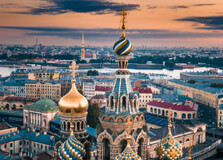
St. Petersburg, Russia’s cultural capital, is a city of artistic grandeur, historic significance, and architectural beauty. Founded by Tsar Peter the Great in 1703, St. Petersburg was the imperial capital of Russia for over two centuries and remains one of the country’s most beloved cities. Located on the Neva River, the city is known for its elegant canals, baroque and neoclassical architecture, and stunning palaces. One of St. Petersburg's most iconic landmarks is the Hermitage Museum, housed in the Winter Palace, which boasts an extensive collection of world-class art, including works by Rembrandt, Leonardo da Vinci, and Michelangelo. Other must-see attractions include the magnificent Church of the Savior on Spilled Blood, the Peter and Paul Fortress, and the stunning Catherine Palace, famous for its opulent Amber Room. St. Petersburg is also renowned for its White Nights, a summer phenomenon where the sun barely sets, and the city is alive with cultural events, festivals, and outdoor activities. The city’s vibrant literary and artistic history is embodied by famous figures like Dostoevsky, Pushkin, and Tchaikovsky. With its canals, historic buildings, and cultural institutions, St. Petersburg offers visitors a deep dive into Russian history, art, and the grandeur of the imperial past.
Explore More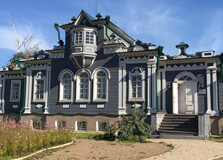
Irkutsk, located in southeastern Siberia, Russia, is a historic city known as the gateway to Lake Baikal, the world’s deepest freshwater lake. Founded in 1661, Irkutsk is one of Siberia's oldest cities, rich in history, culture, and natural beauty. Situated along the Angara River, it is a vital cultural and economic center of the region. The city’s architecture reflects its colonial past, with a mix of Russian Orthodox churches, wooden houses, and 19th-century buildings. One of Irkutsk’s notable landmarks is the Irkutsk Regional Museum, which showcases the region’s history, including its indigenous cultures and Russian settlement. Another key attraction is the wooden architecture of the historical center, particularly the charming wooden houses in the area surrounding Kirov Square. Irkutsk is also famous for its proximity to Lake Baikal, about 70 kilometers away, making it a popular base for travelers heading to the lake. The area offers opportunities for hiking, boating, and exploring the surrounding forests and mountains. In winter, the region transforms into a winter wonderland, ideal for ice fishing, snowmobiling, and skiing. With its mix of history, cultural heritage, and breathtaking natural surroundings, Irkutsk is a fascinating destination for those exploring the heart of Siberia and the mysteries of Lake Baikal.
Explore More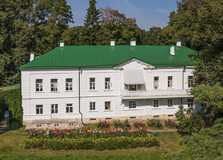
Yaroslavl, one of the oldest cities in Russia, is located on the Volga River, about 250 kilometers northeast of Moscow. Founded in the 11th century, Yaroslavl has long been an important cultural, historical, and economic center in Russia. It is part of the Golden Ring, a group of ancient cities that preserve Russia's heritage and offer a glimpse into its past. The city is known for its well-preserved architecture, especially the iconic churches with colorful onion domes and intricate frescoes. Among the most notable landmarks is the Church of Elijah the Prophet, with its stunning frescoes and striking bell tower, as well as the Transfiguration Monastery, a beautiful example of Russian medieval architecture. Yaroslavl’s historic center is a UNESCO World Heritage Site, reflecting its significance in Russian history. Yaroslavl also boasts a vibrant cultural scene, with theaters, museums, and music festivals celebrating Russian art and tradition. The city’s scenic waterfront, parks, and promenades along the Volga River make it a pleasant place to explore. Yaroslavl’s blend of historical monuments, cultural richness, and picturesque landscapes makes it a must-visit destination for those wanting to experience the essence of traditional Russia.
Explore More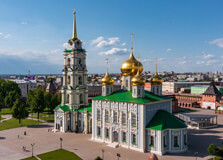
Tula, located about 193 kilometers south of Moscow, is a historic city in central Russia known for its rich cultural heritage, industrial significance, and role in Russian military history. Founded in the 12th century, Tula has long been an important center for the production of weapons, especially during the Russian Empire, and is often associated with the Tula Arms Plant, which still operates today. The city is famous for its well-preserved architecture, including the Tula Kremlin, a 16th-century fortress that stands as a symbol of the city's resilience and military past. Inside the Kremlin, visitors can explore the Tula State Museum of Weapons, which showcases the city’s long history of arms manufacturing. Tula is also known for the beautiful Assumption Cathedral and its 18th-century monasteries, which reflect the city’s deep religious heritage. Tula is often called the "Samovar Capital of Russia," due to its long-standing tradition of crafting these traditional Russian tea kettles. The Tula Samovar Museum offers a fascinating look at this iconic piece of Russian culture. The city's culinary legacy includes *tula prjaniki* (Tula gingerbread), a sweet treat that has been made in the city since the 17th century. Tula’s rich history, industrial roots, and cultural traditions make it an intriguing destination for history buffs and travelers alike.
Explore MoreRussia is a country located in Northern Eurasia. The official name of Russia is Russian Federation. It is a Federal Semi-Presidential Republic. Russian tourism is based on the country’s glacier-capped mountains, historical sites, resorts, nature tourism, national parks, cultural tourism, and broad array of travel experiences in the country.
Russian Ruble (RUB)
17,075,400 square km (6,592,800 square miles)
143,300,000 (approx)
Russian (official)
+7
(UTC+3 to +12)
The climate of Russian has three zones: the arctic, the sub-arctic and the moderate zone. The four seasons in the country are summer, autumn, winter, and spring. Summer varies from warm to cool, while winters range between cold and frozen climate. The capital of the country is frozen by November and remains snowy till April. The coldest place in Russian region is Oymyakon, where the winter temperature drops to -65°C.
Russia is the largest country in the world. It lies between latitudes 41° and 82° N, and longitudes 19° E and 169° W.
Territory & Capital : Russia is bordered by Norway, China, Azerbaijan, Lithuania, Latvia, Finland, Poland, Belarus, Georgia, Kazakhstan, Ukraine, Estonia Mongolia, and North Korea from northwest to southeast. It also has maritime borders with Japan by the Sea of Okhotsk, and the U.S. state of Alaska across the Bering Strait. Moscow is the capital of Russia. It is also the largest city of Russia.
Suitable Visiting Seasons : The best time to visit Russia is either between May and June, or between August and September.
Airlines, Railways, Ships and Road transport are the modes of transport in Russia.
Contact the nearest embassy of Russia for updated details on the requirements for obtaining visa.